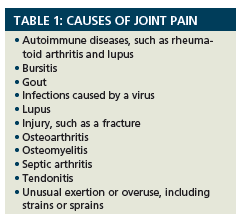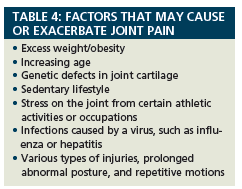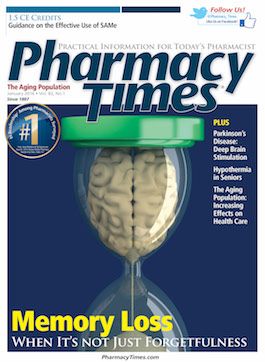Arthralgia: Effective Management with OTC Analgesics
Arthralgia, commonly known as joint pain, can cause discomfort, impair mobility, and negatively impact quality of life.
Arthralgia, commonly known as joint pain, can cause discomfort, impair mobility, and negatively impact quality of life.

Joint pain has an array of causes, including injuries and medical conditions; however, osteoarthritis (OA) is the most common cause for which patients elect to use nonprescription drugs for management (Table 1).1 This article focuses on nonprescription products available for self-treatment and management of joint pain associated with OA.
Signs
OA is characterized by gradual softening and destruction of the cartilage between bones.1,2 Individuals with OA typically experience joint pain and stiffness. The most commonly affected joints include those at the end of the fingers, as well as in the thumbs, neck, lower back, knees, and hips.2 Patients with joint pain may present with achiness or stiffness, mild to severe symptoms of localized or widespread pain that may worsen with any movement, and fatigue due to sleep disturbances caused by uncontrolled joint pain.
Treatment
In general, the goals for treating joint pain involve identifying the cause of pain, decreasing episodes of pain, enhancing mobility, and eliminating the severity and duration of the pain. The therapy selected is typically individualized and depends on factors that include the severity of the OA, the symptoms, and the patient’s medical history, medication profile, and allergy history.3 Therapy may involve a single therapy or a combination, such as the use of an oral and/or topical medication, physical therapy, rest, heat and cold therapy, weight loss, surgery, and the use of auxiliary devices (eg, canes, splints) to relieve strain on joints.2 Pharmacists are in a pivotal position to guide patients in the proper selection and use of nonprescription analgesics for managing and treating joint pain and to advise patients to consult their primary health care provider when warranted, especially if selftreatment is not appropriate, the patient has severe pain or is not responding to self-treatment, or further evaluation is warranted.
Oral Analgesics
Oral analgesics include nonsteroidal anti-inflammatory drugs (NSAIDs) (ibuprofen and naproxen sodium) and acetaminophen (APAP) (Table 2), all of which are often used as initial therapy for musculoskeletal pain.3 NSAIDs and acetaminophen are frequently used for joint pain when no potential contraindications or drug interactions are present.2
Because of its relatively good adverse effect (AE) profile, APAP is considered the drug of choice for treating osteoarthritis of the knee and hip when inflammation is not a chief concern. However, NSAIDs are preferred when inflammation is also present and there are no potential contraindications or drug interactions.2 Patients should be advised to take only the recommended dosage and to adhere to the usage directions to avoid AEs.
During counseling, patients should be reminded to adhere to the warnings indicated on product labels. In July 2015, based on comprehensive reviews of new safety information, the FDA strengthened the existing warning on prescription and OTC drug fact labels to indicate the cardiovascular risks associated with the use of nonaspirin NSAIDs.4 More information on updates that will be included on drug fact labels can be found on the FDA website at www.fda. gov/Drugs/DrugSafety/ucm451800.htm.
Topical Therapies
A variety of topical analgesics are also available for treating joint pain. In some cases, these products may be used in conjunction with oral analgesics (Online Table 3). Topical analgesics typically contain one or more of the following ingredients: methyl salicylate, camphor, menthol, methyl nicotinate, capsaicin, and trolamine salicylate.3 Topical analgesics are available in formulations that include gels, sprays, ointments, creams, lotions, and patches.
Table 3: Examples of OTC Topical Analgesics and Joint Health Supplements
Category/Class
Brand Name/Manufacturer
Capsicum, capsicum oleoresin, capsaicin
· Capzasin Quick Relief Gel
· Capzasin No Mess Applicator
· Capzasin-HP Creme
· Capzasin-P Creme
· Salonpas Hot Capsicum Patch
· Well Patch Pain Relief Patch
· Zostrix Original Strength Arthritis Pain Relief Cream
· Zostrix HP Arthritis Pain Relief Cream
Counterirritants (contains camphor, menthol, or methyl salicylate)
· Aspercreme Pain Relieving Heat Gel
· Bengay Ultra Strength Pain Relieving Cream
· Bengay Zero Degrees
· Bengay Vanishing Scent Gel
· Bengay Ultra Strength Pain Reliving Patch
· Bengay Pain Relief and Massage Gel
· Bengay Cold Therapy
· Blue-Emu Ice Spray
· Eucalyptamint Maximum
· Flexall Maximum Strength
· Icy Hot Medicated Patch
· Icy Hot Knee and Ankle Sleeve
· Icy Hot Micro Medicated Patch
· Joint-Flex Pain Relieving Cream
· Salonpas Arthritis Pain Patch
· Salonpas Jet Spray
· Therapeutic Mineral Ice
· Well Patch Backache
Salicylates (contains trolamine salicylate 10%)
· Aspercreme Analgesic Creme
· Aspercreme Pain Relieving Lotion
· Mobisyl Maximum Strength Arthritis Pain Reliever Crème
· Myoflex Crème
· Sportscreme
Combination products
· ActivOn Topical Analgesic Arthritis
· ActivOn Joint and Muscle
· Arth-Rx Topical Analgesic Arthritis Pain Relief
· Flexall Plus
· Icy Hot Advanced Relief Cream
· Icy Hot No Mess Liquid
· Icy Hot Chill Stick Extra Strength Pain Relieving Crème
· Icy Hot Arthritis Pain Relief Lotion
· Joint Flex Roll On
· Mentholatum Deep Heating Rub
· Salonpas Pain Relieving Patch
· Salonpas Gel Patch Hot
· Salonpas Original
· Salonpas DEEP Relieving Gel
· Sloan’s Liniment
· Stopain Extra Strength Pain relief Spray with Glucosamine & MSM
· Thera-gesic Maximum Strength Pain Relief Cream
· Tiger Balm Arthritis Rub
· Zostrix Joint and Arthritis Pain Relief Cream
Lidocaine HCL 4%
· Aspercreme Pain Relieving Creme with Lidocaine
Miscellaneous
products
· Icy Hot Smart Relief TENS Therapy
During counseling, patients should be advised to only apply topical products to skin that is intact and not to cover areas treated with counterirritants with tight bandages or an occlusive dressing.2 Patients should also be advised not to use heating devices when using topical counterirritants.2 Topical heat therapy patches in various sizes also are available for treating joint pain and can provide 8 to 12 hours of continuous therapy.
The Pharmacist’s Role

Prior to recommending the use of any analgesics, it is imperative to assess the appropriateness of self-treatment by evaluating the patient’s symptoms; reviewing the patient’s medical history, drug profile, and allergy history; and screening for drug—drug interactions and possible contraindications. Patients with preexisting medical conditions, patients taking prescription medications, and pregnant and lactating women should always be reminded to consult their primary health care provider before using any medications. Patients should be advised about possible factors that may exacerbate or contribute to joint pain (Table 4), the proper use of the selected product, and potential AEs.
Pharmacists can also make recommendations about using various nonpharmacologic measures that may alleviate joint pain; these include RICE (rest, ice, compression, elevation), which helps reduce swelling and inflammation associated with some joint injuries, and localized heat therapy, which may be useful for patients with noninflammatory pain. Patients with severe, continuous pain or recurring pain should be encouraged to seek further medical care from their primary health care provider if they see no signs of improvement after using nonprescription analgesics or if pain worsens. Patients should be advised to limit the use of systemic analgesics to 10 days unless otherwise directed by their primary health care provider.
Ms. Terrie is a clinical pharmacy writer based in Haymarket, Virginia.
References
- Joint pain. Medline Plus website. nlm.nih.gov/medlineplus/ency/article/003261.htm. Updated April 18, 2014. Accessed November 10, 2015.
- Osteoarthritis. National Institute of Arthritis and Musculoskeletal and Skin Diseases website. niams.nih.gov/Health_Info/Osteoarthritis. Published April 2015. Accessed November 10, 2015.
- Olenak J. Musculoskeletal injuries and disorders. In: Krinsky D, Berardi R, Ferreri S, et al, eds. Handbook of Nonprescription Drugs. 18th ed. Washington, DC: American Pharmacists Association; 2015.
- FDA Drug Safety Communications: FDA strengthens warning that non-aspirin nonsteroidal anti-inflammatory drugs (NSAIDS) can cause heart attacks or strokes. FDA website. fda.gov/Drugs/DrugSafety/ucm451800.htm. Published July 9, 2015. Updated July 17, 2015. Accessed November 10, 2015.

